For a couple of years, we had a Thetford cassette toilet in our Unimog camper. The emptying experience was far from pleasant.
We hated it. Chemicals are expensive, and finding places to empty them responsibly was often difficult when we were off-grid. Because we live in our van full-time, it was a compromise too far for us.
So when we were designing our Sprinter van conversion, we carefully considered the campervan toilet options.
We decided on a portable composting toilet, and despite the high initial cost, it’s one of the best choices we could have made.
In this post, we’ll share everything you need to know about portable composting toilets to help you decide if this is the best toilet solution for you.
When you click on links to various merchants on this site and make a purchase, this can result in this site earning a commission. As Amazon Associates, we earn from qualifying purchases. For more info, please check our disclosure page.
At a Glance: The Best Portable Composting Toilets
- Nature’s Head Composting Toilet with crank handle
- Nature’s Head Composting Toilet with spider handle
What is a Composting Toilet?
With a regular toilet, human waste passes into a clean bowl of water, flushes away with more clean water, and you probably think no more about it.
With most cassette toilets, the deposits are stored and treated with nasty chemicals until you can dump them somewhere responsible.
A compost toilet works without water or chemicals, so it has less environmental impact than a traditional toilet. A composting toilet works pretty much like your garden composter and relies on aerobic bacteria.
It uses the natural process of evaporation and decomposition to break down the organic matter to put on the compost heap safely.
Because a composting toilet doesn’t use any water for flushing, they’re often called dry toilets.
How Do Composting Toilets Work?
Human waste consists of little more than water, regardless of how it looks! It’s the reaction between the liquids and solids that create that nasty sewerage stench.
Portable composting toilets prevent this stench by using two receptacles to separate liquid waste (your pee) from solids (your poo).
We creatively refer to these as the pee pot and the poo pot.
Pee is directed into the front of the toilet bowl, where it trickles into the pee pot. So, the vast majority of liquids never reach the poo pot.
An organic medium like coco coir, peat moss or wood shavings or sawdust is added to the poo pot.
For pooping, a lever on the side of the throne opens a flap at the bottom of the bowl.
The gravity-fed deposits drop in the poo pot, where the waiting fertilising coco coir is ready to do its business.
When finished, close the flap and, using another handle on the side of the throne, stir the contents.
The poo pot compartment of the composting toilet is fitted with a small 12-volt fan, which runs 24/7 and is vented outside.
This exhaust fan helps to evaporate any moisture to get the composting process working more efficiently on the solid waste.
Pros & Cons Of Composting Toilets
As with everything, there are both advantages and disadvantages of portable composting toilets. We’ll go through a few of them here.
Advantages Of Portable Composting Toilets
Water Conservation
A modern traditional toilet uses around 1.6 gallons of water. Fresh, drinking quality water on every flush. Even RV toilets can use up to half a gallon at best.
The only time you might use water with a waterless toilet is when you flush the pee pot contents into a traditional toilet and rinse the container.
Given the pee pot holds on average 2-3 days worth of pee from 2 people using it full time, by our very ropey maths, that’s a saving of between 10 and 16 gallons every 2-3 days.
That’s a significant difference, especially when considering how energy-intensive creating drinking water and waste management is.
Not only does a composting toilet save water, but it also doesn’t need a water supply like some RV toilets.
No More Black Tanks
If you’ve ever had to empty a black tank or even seen it being done, you’ll know what a God awful task it is.
Plus, a black tank means you’re hauling gallons and gallons of raw sewage around on your road trips.
No, thank you! It’s reason enough to choose a compost toilet.
Less stinky smells
Keeping the liquids separate in a detachable tank from the solids mixed with organic material means that aroma is kept to an absolute minimum.
The only smell you might get from the solid tank is one of earthy soil. And even that is drawn out by the 12-volt fan.
In truth, emptying the pee pot is a stinky job, but you can’t smell anything otherwise.
Disadvantages Of Portable Composting Toilets
Electrical Use
The 12-volt fan uses electricity to draw out moisture from the solid tank, and it runs 24/7.
Honestly, this isn’t a disadvantage, though, because the fan uses around 0.1 amps per hour. That’s about the same as an RV battery monitor and next to nothing. You could leave this running all winter and still not flatten your batteries.
Price
A composting toilet is a significant investment unless you go for the DIY option.
It’s at least seven times the price of a reasonably priced cassette toilet.
A friend of ours recently imported an all singing and dancing Japanese electronic toilet for his house.
It has an Apollo 7 sized control panel with multiple body cleaning functions, a heated seat, perfumed atomising spray and a symphony of musical tunes to cover one’s excretion exertions.
Including UK import tax, it was a lot cheaper than the Nature’s Head!
A composting toilet is little more than a moulded plastic throne, with a couple of receptacles for collecting poo and pee and a small 12v computer fan. The high price is a bitter pill to swallow.
The ongoing costs are reasonable, though, and vary depending on what composting material you use.
How To Use A Composting Toilet
Because composting toilets aren’t so common (yet), unless you’re already familiar with them, you may not know how to use one.
In this section, we’ll go through the parts of a composting toilet, how to “go”, emptying, disposal, and the maintenance and cleaning routines.
Parts Of A Composting Toilet
There are a couple of different manufacturers of portable composting toilet, and each model is slightly different. Even so, their parts are more or less the same.
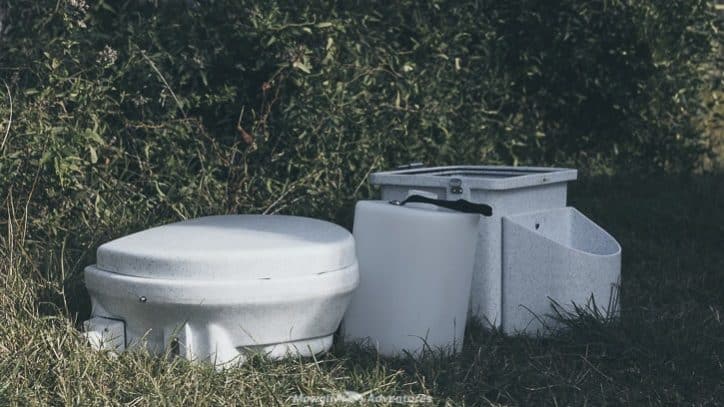
Toilet seat & lid
Hopefully, this needs no explanation, but just in case… this is where you position yourself to make your deposits.
The entire seat section is attached to the solids bin and can be removed when disposing of the contents.
Liquids container (pee pot)
Positioned at the front of the toilet, the separate container holds the urine.
They have a wide opening on most models, so when they’re emptied, the liquid pours away without splashing.
Solid waste tank (poo pot)
The large solid tank holds your poop and where the composting begins.
Crank handle (or spider handle)
A handle at the side of the toilet is attached to an agitator inside the waste tank. It helps to combine your poop with the fertilising material and get the composting process moving.
12-volt fan
Each composting toilet has an integrated 12-volt fan that constantly draws out moisture from the solid waste tank, aiding evaporation and eliminate odours.
How To Prepare The Compost For Use
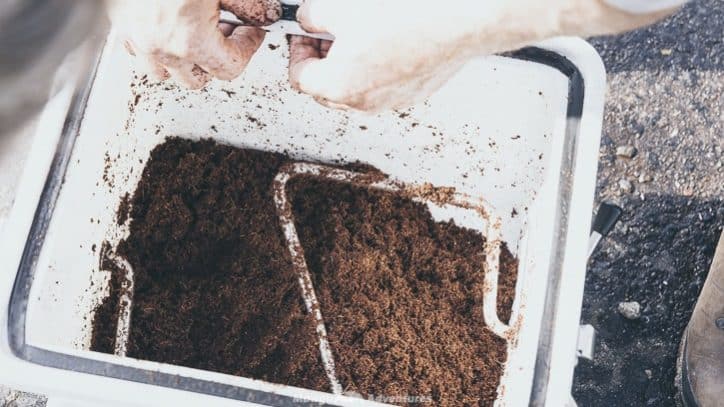
There are different organic materials you can use in the solid tank to get the composting process underway.
You can use sawdust, but most owners of composting toilets use either coco coir or sphagnum peat moss.
We use coco coir, and it’s more eco-friendly than peat moss.
Coco coir is made from the fibres from coconut seeds. It’s packaged into compressed, dry bricks, so it is easy to store in your camper.
The coco coir needs to be rehydrated before use, so it becomes crumbly and a little moist.
Add the water and either work it into the coco coir to help break it up or let it sit for a while. It soaks up the added water and expands a LOT. Aim for a damp but not wet, crumbly consistency.
You need enough composting material in the waste tank to allow the agitator to stir up the contents. Follow the manufacturer’s instructions for the specifics of your chosen model.
You’ll get used to how much coco coir and water you need to create just enough compost to do the job.
If you have made too much, keep any excess in an airtight container for the next time you change the material.
How To “Go”
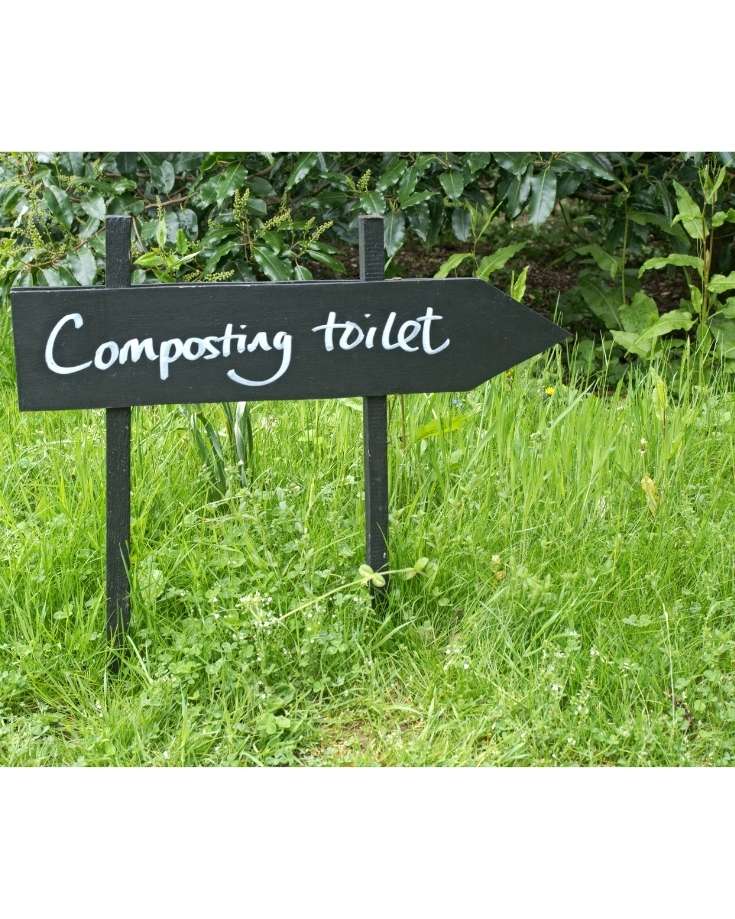
Doing your business in a flush toilet is much the same as going in a cassette toilet. But composting toilets are slightly different.
The single most important thing about using a composting toilet is keeping the solids and liquids separate.
Composting toilets achieve this by diverting urine into a separate container from the poop.
Pee is directed into the front of the toilet bowl, where it trickles into the pee pot. Easy for girls, boys need to sit.
So the vast majority of liquids never reach the dump pot.
For pooping, a lever on the side of the throne opens a flap at the bottom of the bowl. Make sure to open this before you go, or it’s going to result in a messy cleanup job!
The gravity-fed deposits drop in the dump pot, where the waiting fertilising coco coir is ready to do its business. Avoid peeing and pooping at the same time.
When the job is done, simply close the flap and, using another handle on the side of the throne, stir the contents. It’s that simple.
How To Empty A Composting Toilet
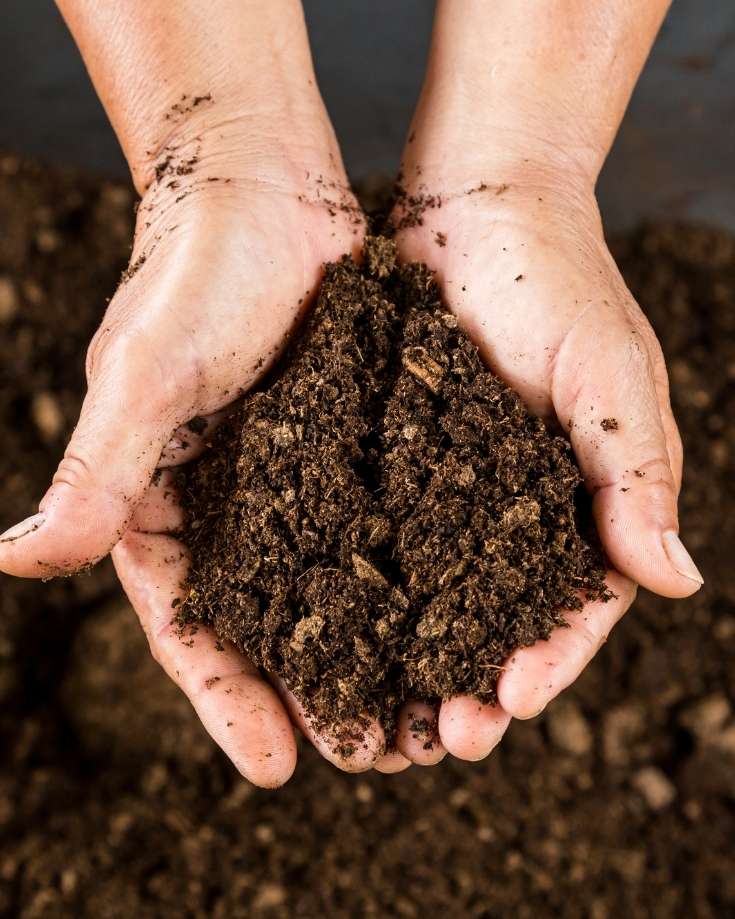
It’s so easy to empty the composting loo. The pee pot gets emptied quite often. With two adults using it full time, we empty ours every three, maybe four days.
Releasing a couple of catches at the side of the throne gives enough wiggle room to lift the pee pot from its cradle. It then gets poured away.
Now, this is the worst part of the whole thing because it stinks. As soon as the pot is removed from the toilet, there’s a pungent stench of ammonia.
After a quick swill with clean water, it pops back into the cradle, ready for the next golden shower.
Easy.
The poo pot is another story, but still easy and, believe it or not, a far more pleasant experience than the pee pot.
Solid waste won’t all become powdery fertiliser overnight, so when the time comes to empty it, try not to use it for a while after your last visit. The manufacturer’s say about 6-8 hours, but the longer, the better.
To empty it, the whole toilet needs to be removed. It comes away in 3 parts, so it’s an easy task.
Clad in rubber gloves, empty the dump pot into a bin liner.
The dryer the box, the easier the contents will pour out, so another reason to try not to use it too soon after its last use.
We use 13 gallons / 60 litres 100% biodegradable trash bags. They fit over the waste box easily, avoiding spillages.
You don’t need to be too fussy about cleaning the poo pot either. Leaving some of the excess material behind will help start the next composting batch.
Once the fresh composting material is ready, we rub it around the tank’s walls and the agitator to give it a good clean.
Reassemble the toilet and replace it. Done! Compare that to emptying a camper’s chemical toilet or an RV’s black tank!
Disposing Of Human Waste
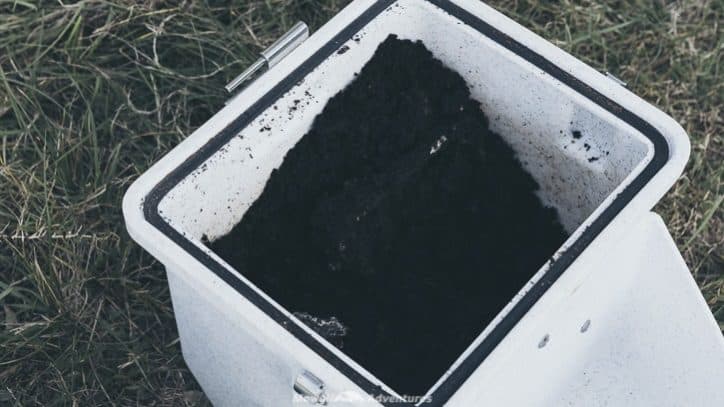
Ok, so “going” in a composting toilet is easy and emptying it is verging on pleasant, but where can you dispose of human waste?
Before you get freaked out, remember how waste is treated in a composting toilet is not the same as the waste flushed into sewer systems or a septic tank.
The latter simply combines all waste – pee, poop, toilet paper, sanitary products and anything else thrown down the toilet – into a central system and sent to wastewater treatment plants.
Unlike flush toilets, all waste in a composting toilet is separated to be dealt with responsibly.
Where To Empty The Pee Pot
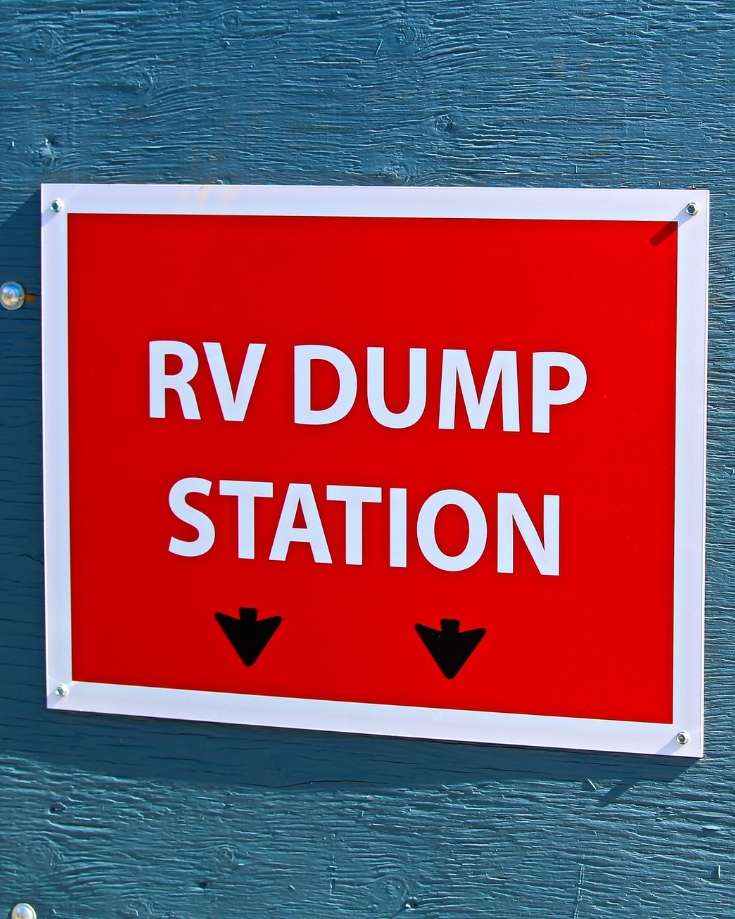
Urine isn’t sterile, but it isn’t toxic either. With that in mind, you could theoretically dump it anywhere.
However, bearing in mind the unpleasant aroma, you should really be more considerate than simply pouring it away into someone’s garden.
Campground toilets, public bathrooms or RV dump stations are ideal for emptying the pee pot. They’re obviously designed to cope with human waste.
Choose public bathrooms wisely, though. Personally, we wouldn’t want to walk through a coffee shop with our pee pot (even if disguised in a bag). And if anyone got a whiff of the stench while you’re emptying the pee pot….well, it’s not likely to make you any friends.
If you need to empty you pee pot outside, do so responsibly:
- Avoid places used by lots of people
- Be considerate to your neighbours
- Pour it onto organic matter where it can be absorbed (so not on the street)
- Spread the urine out over a wide area rather than pouring it in one spot
- Don’t pour urine within 200 feet of any water source
Where To Empty The Poop Pot
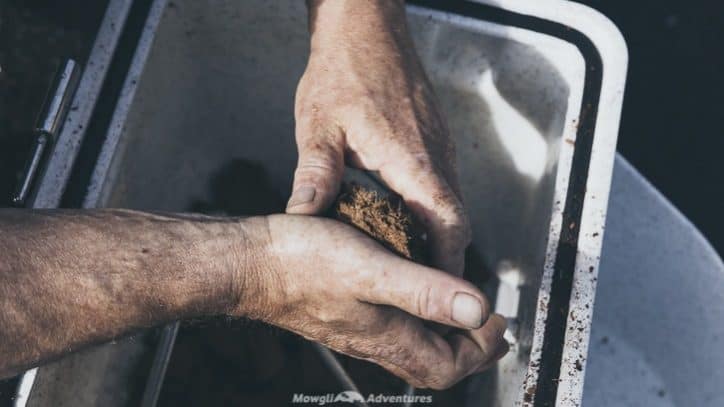
The first thing to know is your composting toilet has probably not turned your poop into compost by the time it needs emptying.
In reality, even when using your composting toilet in the perfect conditions and in exactly the right way, the waste could need up to 18 months to truly become compost.
The chances are most of us, even those that don’t live in their vans full-time will need to empty the composting toilet more frequently.
With this in mind, the contents of the solid tank are likely to have some bacteria still and certainly won’t be safe, usable compost by the time you empty it.
You have three options to get rid of your composting toilet’s solid waste:
- Compost pile (ask the owner of the composting pile first)
- Put it in the regular trash (it’s treated the same as babies diapers)
- Bury it in remote areas (a pretty deep cat hole would be needed for up to 5 gallons of waste)
Local regulations about disposing of human waste may vary, so always check first.
Portable Composting Toilets: A Buyer’s Guide
Our composting toilet has been in situ for over three years now, and we use it pretty much full-time.
Because they’re not cheap, there are few things to consider before choosing the best portable composting toilet for you.
Space Needed
Composting toilets tend not to be a small size like some cassette toilets.
Make sure to check the space needed to install the composting toilet and not just its footprint.
Your bathroom needs to be big enough to lift the lid, sit on it, and the door needs to be wide enough to remove it without too much drama.
It also needs to be vented. Depending on how the vent is attached to the toilet, you may need extra space. Always check the manufacturer’s instructions for total installation and use dimensions.
Also, consider where you will store a supply of coco coir. It tends to come in multipacks of 1lb briquettes.
Ease Of Installation
Even portable composting toilets need some installation. A vent needs to be routed outside, an electricity supply installed for the fan, and the whole toilet needs to be secured.
You don’t want that shifting around as you drive.
If you’re handy with installing your campervan electrics and fitting out your conversion, it isn’t a troublesome task.
Do note, though, to install the ventilation correctly, you’ll need to make a hole in the van floor, wall or roof.
Weight
When it comes to emptying the poo pot, you may need to move the entire toilet. A full composting toilet could weigh up to 60lbs.
That’s a hefty weight to be moving through your camper, so it’s often better to take it apart inside.
Best Composting Toilets For RVs & Campervans
In our opinion, the top portable composting toilets are the Nature’s Head Composting Toilet and Air Head Dry Composting Toilet.
Nature’s Head Composting Toilet
We have a Nature’s Head Toilet and rate it as one of the top ten gadgets for campervans, motorhomes & RVs.
The Nature’s Head includes everything you need to install the toilet like the ventilation pipe, brackets to secure it to the floor and 12-volt fan.
Choose between the spider handle or the crank handle agitators. The crank handle version needs about 3” more space than the spider handle, so the latter is probably the better option for space-saving.
The dimension of the Nature’s Head means it can be installed in a van conversion with a bathroom or a drawer or storage cupboard so it can be hidden when not in use.
We love our Nature’s Head. Cleaning is simple, and emptying it is no drama. Having used a cassette toilet in the past, we’d never go back. Even though the composting toilet is more expensive, we consider it well worth it.
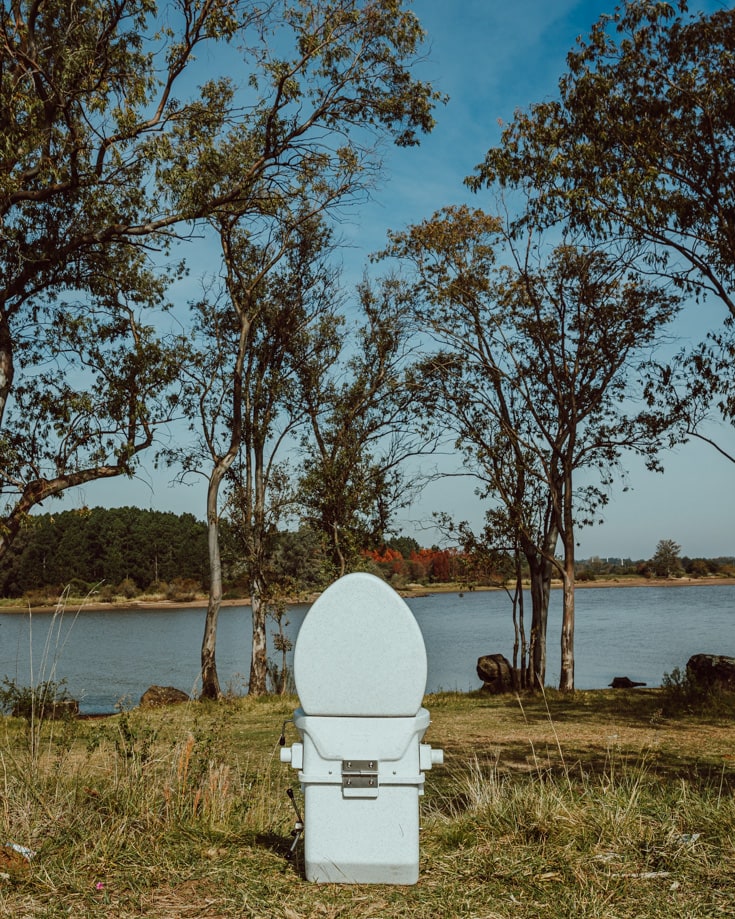
Alternative Composting Toilets
In our opinion, the Nature’s Head is the best portable composting toilet for campers and RVs, but there are alternatives too.
The Air Head Dry Composting Toilet is similar to the Nature’s Head. Its overall dimensions are a little smaller, but its price is higher. Which you choose is down to personal preference.
The Sun-Mar Excel is another popular option, but it weighs a whopping 100 lbs and costs more than both the Air Head and the Nature’s Head.
Be cautious with other models calling themselves composting toilets. Some are more like dry, waterless toilets than composting toilets. The main difference is they don’t dehydrate the contents with ventilation.
You could try a low-cost bucket toilet, like the Stansport Portable Toilet or the Reliance Luggable Loo, for a cheap option.
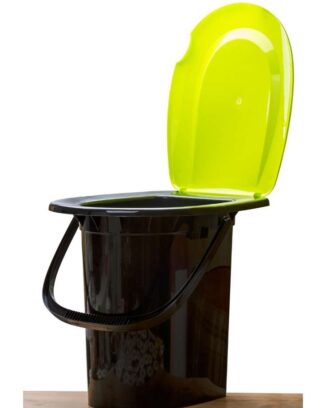
Frequently Asked Questions About Composting Toilets
Do you use toilet paper with a composting toilet?
You can throw used toilet paper into the solid waste tank. However, toilet paper takes a lot longer to decompose than human waste. The solid tank will fill up more quickly, so it needs emptying more often. We use a separate bin lined with lightly scented biodegradable nappy sacks to dispose of our toilet paper.
How often do you have to empty a composting toilet?
How often you use the toilet and what size liquid container your model has will determine how often it needs to be emptied. Our liquid container holds 2.2 gallons. With the 2 of us using it full-time, we empty it every 3-4 days.
Once the handle on the solids tank becomes more difficult to turn, it’s time to empty it. For us, this is about once a month. The manufacturer recommends emptying it after 60-80 uses. We think not adding toilet paper to the pot helps extend this a little.
If you don’t live in your van full-time or use the composting toilet infrequently, you can leave the solid tank for months because the waste will continue to break down.
Do composting toilets stink?
The short answer is no. The long answer is not if you use the toilet correctly. Composting medium shouldn’t be too wet, and don’t pee in the solid waste tank. Emptying the solid’s tank doesn’t smell bad – it smells like earthy soil. Emptying the urine tank is the worst smell – thing strong ammonia – but you only experience this when emptying it.
Are composting toilets worth it?
The best portable composting toilets aren’t cheap. But with the advantages to the environment and how much more pleasant and convenient, the whole emptying process is, we think they are totally worth it. But this is only our opinion. If you don’t have the budget, you may need to consider a DIY composting toilet or another alternative.
Angela Devaney

Angela Devaney, a former IT project management professional, embarked on an adventurous journey of full-time travel, which included touring West Africa in a converted overland truck and converting an ex-military 4×4 Sprinter van into a camper for a five-year South American expedition. She now utilizes her hands-on experience to create practical RV living and van life advice as a full-time digital media producer, reaching over a million users annually through her YouTube channel, blog, and newsletter. Angela also lends her expertise as the editor-in-chief of the Campervan Electrics Handbook.


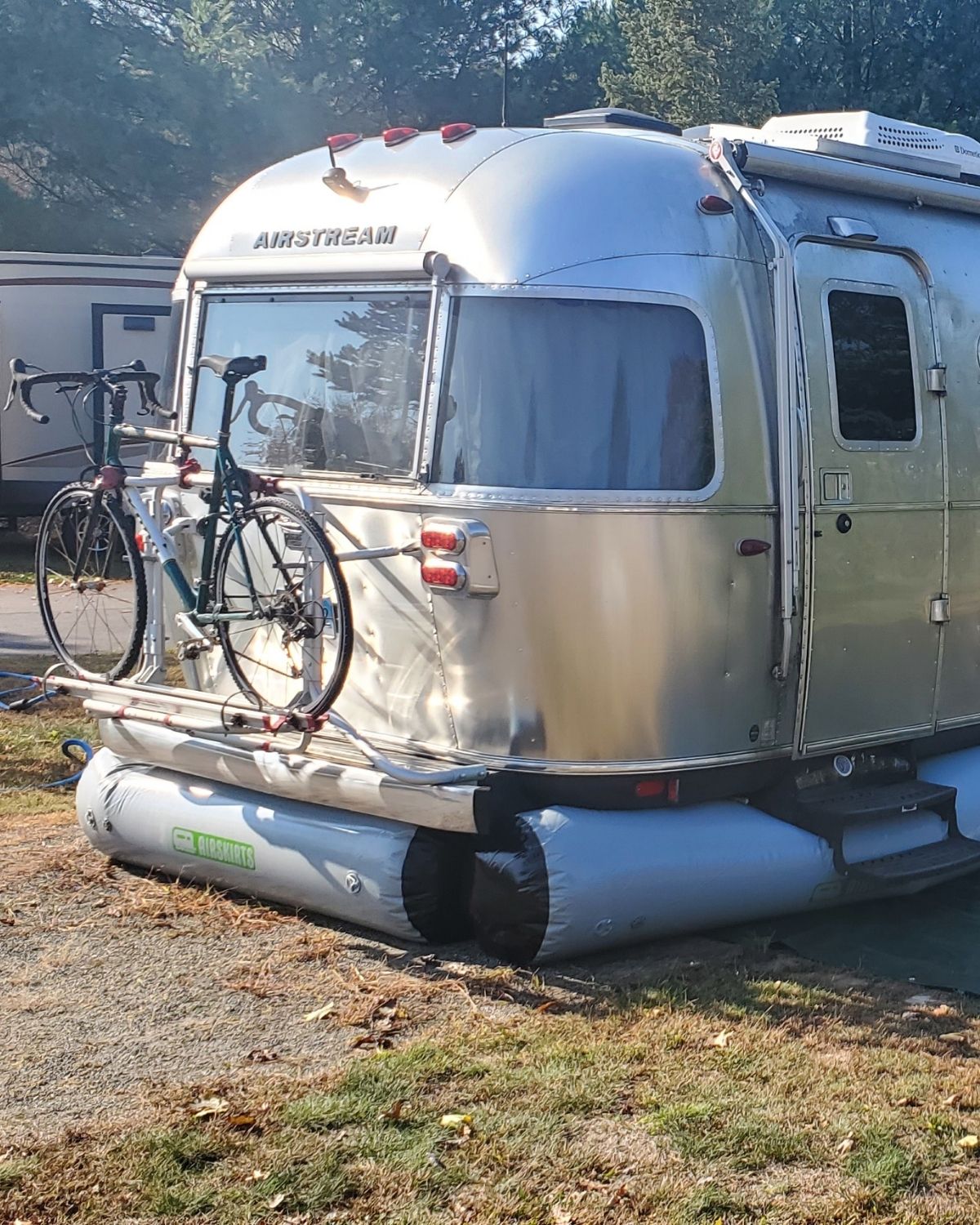

I’m looking for a portable non chemical toilet for a sick person. The toilet would need to be taken in and out of the room daily – would this be possible with a composting toilet? If not, any other ideas?
Its so tall though!
Was all set to buy a natures head composting toilet.
Restricted on space I planned to hide it in a box seat but the blimmin thing seems to have been designed for giants!
Its a whopping 10cm higher than my house loo.
By the time I build the box and put a cushion on top, I’ll need a ladder to sit on the chair!
I’d suggest this a biased review, the airhead is a worthy if not a superior alternative which you mention as a passing mention. I get the impression you haven’t used one.
here’s their website for those interested: https://airheadtoilet.com/
Dan – Not sure what part of the post you think is biased against the AirHead. This isn’t intended to be a review of every composting toilet out there – rather a resource for people to learn more about how they work and introduce some options – including some of the market leaders. We have a Nature’s Head so no need to install an AirHead as well. The post is clear that Air Head & Nature’s Head are the top 2 products on the market, in our opinion. And by that, we stand. Can you add any info on the Air Head that would allow others to compare them?
Great review! I would add one bit of advice…
If you substitute the coco coir with peat moss (many people do because it’s cheaper and easier to find), be sure to microwave the peat moss for 30-45 secs before adding it to the toilet.
Peat moss sold in big box stores and garden centers will often contain live bug larva and a quick nuke in the microwave will ensure you don’t introduce bugs to your compost toilet by accident.
Thanks for the review. I can see this would be more beneficial than a chemical toilet if you only need to empty it once every 9mths, but the pee every 3 to 4 days ooow no. That rancid pee smell is much worse than my chemical toilet which I find no problem emptying. I run a campsite and often look at compost toilets and done lots of research into them. I am surprised you didn’t make your own based on this one. Maybe put a pipe with a valve to the outside from the pee pot, no need to remove just open the valve at the side skirt of the van into another pot, no spill/splash issues when removing it! In the desert etc you would just open valve and water the ground!
Great site you are doing a fab job.
Dave
Hi Dave – thanks for taking the time to comment and for your kind words. You’re right – the pee pot pongs and so long as we don’t leave it to the last minute, we suffer no splashing. Love the idea of a valve though – that would make it completely perfect! :-)